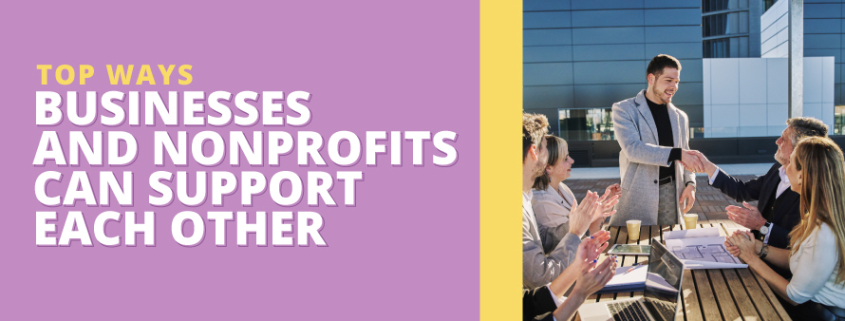4 Ways Businesses and Nonprofits Can Support Each Other
Businesses and nonprofits seem to belong in separate worlds. However, they share many common goals, from winning the support of their communities to maintaining trust and transparency in their practices. By working together, they can build on each other’s strengths and unlock new opportunities to reach their goals.
According to Double the Donation, 71% of employees believe it’s important to work at a company that gives back through philanthropy and volunteering. Plus, 73% of investors look to support companies that improve the environment and society as a whole. As corporate social responsibility (CSR) continues to become an expectation among today’s companies, it’s the perfect time to tap into the potential of business-nonprofit collaborations.
Businesses and nonprofits can support each other in many ways, from matching employee donations to launching joint marketing campaigns. Let’s explore a few top partnership ideas your organization can pursue.
1. Cause Marketing
It’s no secret that businesses must launch strategic marketing campaigns to boost brand recognition, reach new customers, and build lasting relationships with existing ones. Through cause marketing, companies lend their marketing platforms to promote a nonprofit’s cause. The nonprofit receives increased awareness and funds, while the company receives a reputation boost for its commitment to social impact.
There are several common types of cause marketing campaigns to consider, including:
- Percentage of sales: Businesses donate a portion of their sales or profit to a nonprofit, usually for a specified period of time. This policy can apply to all products and services or only a specific item or offering. For example, for one month, a video game store might give 10% of every purchase to a local digital literacy organization to support its technology training program.
- Buy one, give one: For every product a customer purchases, the business donates another to a nonprofit. This kind of agreement can be particularly engaging for customers since they can see how their patronage directly impacts their community. Warby Parker is a well-known example of this type of cause marketing, partnering with the nonprofit VisionSpring to give away one pair of glasses for every pair sold.
- Point-of-sale donations: During in-store or online checkout, businesses can prompt customers to opt into giving to their nonprofit partner. Typically, customers can either round up their purchase amount or choose to donate $1-$5 on top of the total price. This option provides a convenient and non-intrusive way for customers to participate in your company’s philanthropic efforts.
Additionally, businesses can use their website, social media, and email newsletters to advocate for causes. Sharing relevant statistics and social media challenges calls more attention to a nonprofit’s fundraising needs while broadening the company’s reach to new, socially conscious customers.
2. Volunteering Opportunities
Nonprofits need volunteers to push their missions forward, whether through operational support or direct service delivery. At the same time, employees who volunteer together benefit from bonding with their team members, developing leadership skills, and giving back to their community.
Rather than simply promoting local opportunities, companies can organize dedicated team volunteering events with nonprofits. This way, the nonprofit receives direct support, and your business gets an impactful team-building activity to engage employees.
To set these events up for success, be sure to:
- Survey employees. Maximize participation by focusing on causes employees care about most. For instance, if many employees are passionate about preserving cultural heritage, you could plan a volunteering day at a local museum, helping the staff catalog and scan archival materials for digital access on its website.
- Incentivize participation. While businesses shouldn’t require employees to volunteer, there are steps you can take to promote engagement and remove barriers to participating. For example, you might provide volunteer time off (VTO) to those who sign up for the event or a free company lunch afterward.
- Report impact. With enough employee support and passion, a team-wide volunteering day can become a quarterly or annual event. Keep employees motivated to continue participating by updating them on how their time and energy made a difference. For instance, a company might report that, during its volunteer event with a local food bank, employees sorted and packed over 4,000 lbs. of food to prepare around 4,000 meals for the community.
Companies can also launch Dollars for Doers programs to encourage employee volunteerism beyond team events. Uncommon Giving’s Dollars for Doers guide defines this type of program as “a corporate giving program that encourages employee volunteerism by matching the hours they contribute to nonprofits with financial donations.” For example, one business might make a $500 donation to a nonprofit organization after an employee volunteers 50 hours.
3. Monetary and In-Kind Donations
Many companies help employees champion causes close to their hearts by matching donations to nonprofits at a dollar-for-dollar rate or higher. Through matching gift programs, companies can demonstrate their values and inspire a sense of pride in their employees while providing nonprofit organizations with the funding they need to fulfill their missions.
Beyond matching gifts, businesses can contribute goods or services that allow nonprofits to cut costs and enhance program delivery. These in-kind donations can include:
- Surplus inventory: Businesses can donate clothing, furniture, office supplies, paper products, and more.
- Professional services: Many nonprofits will appreciate free or pro bono services like legal counseling, graphic design, financial planning, or technical support.
- Event space: Hotels or restaurants can donate event space for nonprofit gatherings such as galas or art shows.
- Auction items: Companies can help nonprofits raise more at their auctions by donating enticing items such as gift baskets, sports tickets, and spa vouchers.
Generally, in-kind donations are tax-deductible for businesses. However, nonprofits must first provide a written acknowledgment for these types of donations and estimate their fair market value (FMV).
4. Event Sponsorships
Nonprofit events bring communities together and generate significant revenue through engaging activities such as auctions and peer-to-peer fundraisers. Yet, planning these events is often costly.
To help nonprofits accomplish their goals, businesses can become event sponsors, donating money to cover major event expenses and potentially even using their platforms to drive registrations. In return, they receive brand exposure at the event. Some popular perks include:
- Event naming rights
- Logos on event banners and posters
- Branded badges or nametags
- Speaking opportunities
- Social media shout-outs
- Branded video ads during virtual events
Pave the way for long-term partnerships by looking for nonprofits that align with your company’s mission and values. For instance, a renewable energy business might sponsor organizations dedicated to reforestation or sustainable food production, while a toy company might sponsor organizations that promote children’s literacy or youth mentorship.
When a partnership takes off, your business should be able to use its CSR software to measure participation and impact. By tracking which volunteer events get the most sign-ups and which marketing activities generate the most engagement, you can adjust your strategy to continually improve results and deepen nonprofit partnerships for the future.



